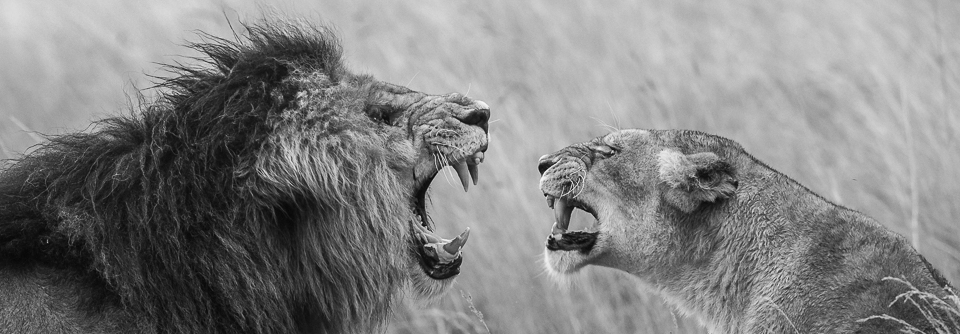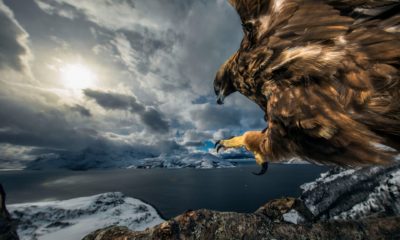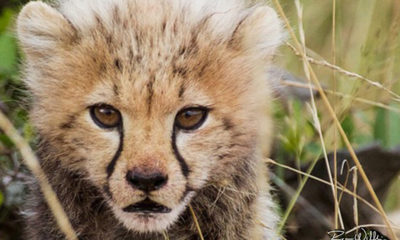Wildlife Photography
Bringing Home the Human-Lion Conflict
What happens when a lion kills a cow? The carcass sometimes has poison put on it, as retaliation from the owner of the animal. But what if we could avoid all this?
Published
7 years agoon
By
Guest Writer
Moira Norrie is a renowned photographer focusing on the beautiful animals in Kenya’s Masaai Mara, and shares with us her insights into the human-lion conflict besetting the area.
By Moira Norrie
When I pack my camera bag next month and announce that I’m off on safari, I’m sure some friends will ask where I’m going and look rather bemused when I say that I’m heading to the Maasai Mara in Kenya yet again. They clearly wonder why I visit the same place so often instead of exploring new locations. So why do so many wildlife photographers keep returning to the Mara? The obvious answer is the abundance of predators with the possibility of seeing one of nature’s wildlife spectacles – a migration crossing – if you go between August and October. But what is often not appreciated is the fact that returning regularly allows you to not only see and photograph animals in their natural habitat but also to follow their stories.
Some animals can be considered wildlife celebrities of the Mara. The cheetah Malaika is known as a good mother having successfully raised a number of cubs and photographers are always keen to spend time with her and her latest litter. There are few better photographic opportunities than watching them play in the early morning sun.
Another wildlife celebrity is Fig, a female leopard whose territory is in the Olare Motorogi Conservancy bordering on the Maasai Mara National Reserve. She is a favourite with many photographers as she often gives the impression of posing beautifully and performing just for them. These performances often involve interaction with her cubs whether grooming, playing or squabbling over a kill. Olare Motorogi is one of five wildlife conservancies set up in the Mara as a major conservation effort. Each conservancy leases land from the local Maasai people and revenues from tourism are invested back into the local communities and ecosystems.
The stars of the Mara must surely be the Marsh Pride of lions which has featured in many wildlife documentaries, most notably the long-running BBC documentary series Big Cat Diary, Big Cat Week and Big Cat Live which ran between 1996 and 2008. In recent years, brothers known as The Four Musketeers have been the leaders of the pride. One of the brothers, Scarface, is easily recognised due to an injury to his right eye sustained during a fight in 2012 when the brothers tried to take over another pride. Despite, or maybe because of, his scar, he seems to be quite a hit with the ladies, and I’ve even photographed his mating activities during a heavy rainstorm.
Having spent a lot of time with various members of the Marsh Pride, it was particularly heartbreaking when news broke in December 2015 that several of its lions had been poisoned. In retaliation for a livestock kill, poison had been put on the carcass of the cow as it was known that the lions would return to it. Several lions were affected and three of them died. Bibi, a 17-year-old female lioness who featured in the Big Cat Diary, was found by a BBC wildlife crew who reported that she “was lying on her side, foaming at the mouth, fitting and panting”. She later died. A young male lion, Alan, was euthanised a few days after the attack as he was too weak to avoid being trampled by a herd of buffalo. The lioness Siena was missing and, after a few days, presumed dead when she didn’t reappear. A lion carcass that was no longer identifiable after being eaten by hyenas had been found after the poison attack and so it was assumed that this was Siena.
I felt particularly sad about Siena as she had come through some very tough times in the previous two years. Her most distinguishing feature had been a floppy left ear up until she sustained a major injury to her left flank after being gored by a buffalo in April 2014. The David Sheldrick Wildlife Trust (DSWT) were alerted and they arranged for her to receive treatment. She recovered well but a fight with another lioness in August 2014 caused the wound to open and she had to receive more treatment.
One year to the day, in August 2015, the veterinary team had to be called when she was found with multiple wounds – including the old wound which had opened up once again. It was assumed that these injuries were the result of a fight with other lionesses. She received further treatment in September 2015 after which it was reported on the DSWT website that she was “again beating the odds and healing miraculously”.
She had continued to try and protect both her cubs and her pride throughout these difficult times but, finally, what she could not overcome was a poison attack carried out by humans. This really brought the human-lion conflict home to me.
It is difficult for visitors to the Mara to understand how members of the local communities can deliberately kill such magnificent animals, especially when they are the source of valuable tourist income. Research has shown that there are many complex social, economic and ecological factors that have to be taken into account when trying to understand and find a solution to the human-lion conflict.
Wherever lions and humans live in close proximity, there will be some form of conflict. Actions that have been taken to address the specific problem of lions killing livestock include compensation schemes as well as improvements in husbandry practices to protect livestock. However, mitigation strategies need to be situation-specific given the variety of factors that may be involved.
To gain a better understanding of the problem, researchers carried out a detailed study of attitudes towards retaliatory lion killings in communally-owned Maasai land close to Amboseli National Park [1]. The study took place between May 2005 and April 2006. Results showed that individuals who kept livestock for sale, rather than purely for domestic consumption, were twice as likely to kill a lion. At the same time, those with few livestock were less tolerant than those with large herds due to the greater significance of a loss.
Interestingly, religious affiliation was also found to be an important factor: 48% of those who participated in the study belonged to an evangelical sect, and a much higher percentage of them (35%) said that they would kill a lion compared to those affiliated with other churches or no church (14%). The researchers speculated that this might highlight an important link between religion and conservation, since the evangelical sect stressed the dominance of humans over animals, while other religions promoted stewardship and accountability which encouraged tolerance.
Apparently, the Catholic Church in Kenya is one of the few that includes environmental issues in its sermons.
Other field research in the Ngorongoro Conservation Area of Tanzania [2] indicated that lions could distinguish warriors from children as there were more than five times as many attacks when children were solely in charge of herds rather than men. This suggested that the number of lion attacks could be reduced significantly by persuading the Maasai to send their children to school, which clearly would have other benefits and help meet the government aim of achieving universal literacy.
Generally, it has been found that, although other predators kill more livestock than lions do, there are more retaliatory killings of lions. Hyenas and leopards often kill smaller livestock such as sheep and goats, which are less valuable than cattle. They also tend to move away from the location of the kill or hide themselves, while lions are much more likely to defend a carcass and return to it. This makes it easier to find them, and the knowledge that they are likely to return to a carcass leaves them vulnerable to the easy and cheap option of poisoning.
Attempts to discourage retaliatory killings by introducing compensation schemes have had mixed success, depending on the implementation. Some schemes offer only partial compensation and, in many cases, there are lengthy delays in receiving the funds and/or complicated application procedures. Unsurprisingly, many of those who lose livestock to lions are not motivated to apply as a result.
The main problem underlying the human-lion conflict is the increasing competition for grasslands, especially during the dry season. Although the Maasai people are not allowed to graze their cattle in the Maasai Mara National Reserve, the lack of strict controls means that they do so under the cover of darkness, leaving their cattle vulnerable to attacks by lions. At the same time, there are no fences around the Reserve and lions will attack livestock in nearby communities if it is not well protected. Lions such as the Marsh Pride which live close to the boundary are therefore particularly likely to be part of the human-lion conflict.
There are a number of commendable projects that aim to reduce the conflict in a variety of ways ranging from financially supporting the construction of more robust enclosures (bomas) to encouraging the Maasai to use bank accounts rather than investing their money in cattle, which have traditionally been a symbol of status and wealth. However, one of the most important factors must be to ensure that the local communities directly experience the financial benefits that the lions bring through tourism.
The Mara conservancies have demonstrated the advantages of engaging members of the local communities in conservation [3]. By leasing their land to safari camps, the Maasai have gained a reliable, steady income. They are also allowed to graze their cattle in a controlled way, where the cattle are moved from one area to another, leaving short grass areas favoured by certain herbivores. The restrictions on the numbers of camps and tourists in the conservancies, as well as the strict environmental policies enforced, benefit both the wildlife and the visitors. Research has shown that lion densities have increased substantially within the conservancies which suggests that the model operated by the conservancies does indeed promote lion survival.
My hope as a wildlife photographer is that my images might play a small part in spreading a love of lions and raising awareness of their plight.
I also contribute financially to conservation projects closest to my heart and add my voice to those that oppose hunting. But I believe that it is mainly up to the local and national governments of Kenya and other countries affected by the human-lion conflict to bring about the changes necessary to resolve the situation.
The question is what, if anything, I and other wildlife photographers can do to encourage them to act. I know many who are trying and applaud them.
Follow Moira’s photography feed on Instagram here to support her work, and check out her website here!
Captions and credits for images, from top-down:
– Moira Norrie: Malaika [All Rights Reserved]
– Moira Norrie: Fig [All Rights Reserved]
– Moira Norrie: Siena [All Rights Reserved]
– Moira Norrie: Scarface [All Rights Reserved]
– Moira Norrie: Siena [II] [All Rights Reserved]
References:
1.L. Hazzah, M.B. Mulder and L. Frank, Lions and Warriors: Social factors underlying declining African lion population and the effect of incentive-based management in Kenya, Biological Conservation, 142 (2009), 2428-2437.
2.Managing Human-Lion Conflict, College of Biological Sciences, University of Minnesota, https://cbs.umn.edu/research/labs/lionresearch/research/managing-human-lion-conflict
3.S. Blackburn, J.G.C. Hopcraft, J.O. Ogutu, J. Matthiopoulos and L. Frank, Human-wildlife conflict, benefit sharing and the survival of lions in pastoralist community-based conservancies, Journal of Applied Ecology, 53 (2016), 1195-1205.
You may like
-


Mammal Photographer of the Year Winners 2020 Announced
-


Wildlife Photographer of the Year 2019 – The Winners
-


Comedy Wildlife Photography Awards 2019 – Finalists Announced
-


Race for Survival: The Cheetah
-


See the winners of the LUMIX Wildlife Photographer of the Year Award 2019
-


Nature Conservation: Making it count

Blakiston’s Fish Owl

Kakapo

A vote to focus attention on Australia’s amazing animals, and their alarming decline

Mexican Grey Wolf

Penguin run undergoes UK sport commentary

Penguin run undergoes UK sport commentary

Seven Worlds, One Planet – Extended BBC Trailer

Thunberg: We will never forgive you

Bilbies Released Back into the Wild in 2018



You must be logged in to post a comment Login